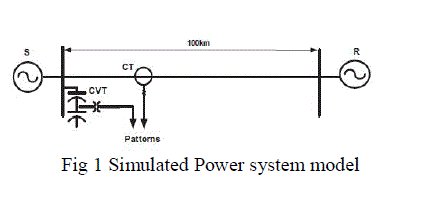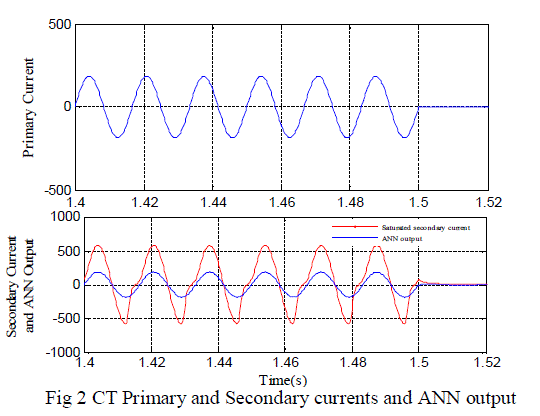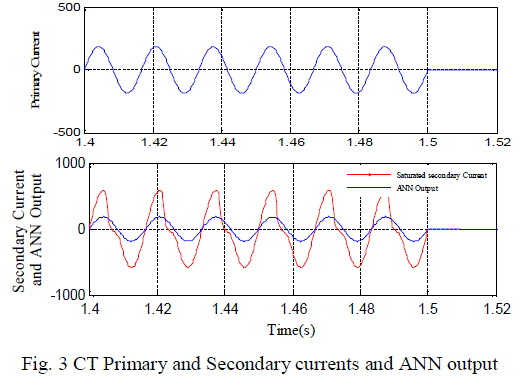ISSN ONLINE(2278-8875) PRINT (2320-3765)
ISSN ONLINE(2278-8875) PRINT (2320-3765)
Linimol Ansalam A V
|
| Related article at Pubmed, Scholar Google |
Visit for more related articles at International Journal of Advanced Research in Electrical, Electronics and Instrumentation Engineering
Intelligence based protective relay data acquisition system is used to correct current transformers (CT) secondary waveform distortions. CTs provide instrument level current and voltage signals to meters and protective relays in high voltage and extra high voltage systems. The accuracy and performance of protective relays in high voltage and extra high voltage systems are directly related to steady state and transient performance of CT. CT saturation could lead to protective relay mal-operation or even prevent tripping. The key of the proposed scheme is to use artificial neural network (ANN) to achieve the inverse transfer functions of CT. Simulation studies are preformed and the impacts of changing different parameters are studied. Performance study results show that the proposed scheme is accurate and reliable. The proposed algorithm has also been implemented and tested on an Omicron 356 relay testing unit.
Keywords |
| CT, Saturation, ANN. |
I.INTRODUCTION |
| Power system is a highly complex and dynamic entity .It is always in a state of flux. Power system protective relays are playing an increasingly important role in power system. Protective relays are meant to mitigate the effects of faults. A protection scheme in a power system is designed to continuously monitor the power system to ensure maximum continuity of electrical supply with minimum damage to life, equipment, and property. Protection system operation is dependent on the performance of instrument transformers. Instrument transformers are based on electromagnetic coupling between power network on the primary side and protective devices on the secondary side. Inherent to this coupling are signal distortions in various forms. These distortions are in a sense, artificial: they do not originate from the power network, but are inserted by the coupling within the instrument transformers. Protective devices may be sensitive to signal distortions regardless of their sources. |
| Protective relays clear system faults with high degree of reliability and as fast as possible. To be able to perform properly, they require reasonably accurate reproduction of the primary current signals during system faults. In this respect, current transformers (CTs) are employed to provide reduced version of the primary current in high voltage (HV) and extra high voltage systems (EHVs). They provide access to high-magnitude currents on the power network, by supplying signal replicas scaled-down to levels that are safe and practical for use by protective gear. The performance of CTs when they are carrying load currents is not of concern as far as relaying needs is concerned. When faults occur, the current magnitudes could be much larger, the fault current may have substantial amount of DC components, and there may be remnance in the CT core. All of these factors may lead to saturation of the CT core, and cause significant distortion of the secondary current. A CT may not represent the primary current faithfully if the CT goes into saturation, and saturation can lead to severe signal distortions in the CT output. Hence relays that depend upon the secondary current are likely to mis-operate during this period and CT saturation could lead to protective relay mal-operation. |
| AI-based techniques have been used in power system protection, feed forward neural network-based data acquisition scheme that compensates CT secondary current. This scheme accurately estimates the ideal CT, which are the secondary current defined by the primary current and the ratio of CT, especially when there is CT saturation. Feed forward neural networks improve the CT output during CT saturation and reduce the impacts of certain variables such as incidence angle, magnitude of voltage change, remnant flux, time constant and burden on CT output. Simulation results clearly demonstrate the capability of the proposed scheme to provide good estimate of the primary current and voltage in the presence of CT saturation. The proposed method has also been implemented and tested on an Omicron 356 relay testing unit. |
II. STRUCTURE OF DIGITAL PROTECTIVE RELAY |
| The first part of each digital protective relay is data acquisition system. Conventional data acquisition systems (DASs) generally do not pay much attention to the performance of instrument transformers. Some necessary pre-processing is done in conventional DASs, such as filtering to prevent from anti-aliasing, sampling, and converting analog data to digital information. The converted digital information is given to relay’s algorithm for fault detection and decision making. But this information may not appropriate to reliable operation of protective relays. |
| Data acquisition card prepares necessary information for relays to detect equipment’s condition after some preprocessing and converting analog data to digital data. This card includes active low pass filters, sample holders, an analog multiplexer (MPX), and an analog-to-digital (A/D) converter, which provide such functions as sampling and A/D conversion of the instantaneous voltage and current data, which are then introduced to the main board card. The major problem with the conventional data acquisition system is that inputs to the DAS including currents and voltages are sometimes very different from the high voltage quantities (in terms of per unit) because of the misbehavior of CT. |
III. ARTIFICIAL NEURAL NETWORK |
| An ANN is characterized by its architecture, training or learning algorithms and activation functions. ANN models attempt to use some “organizational” principles believed to be used in the human. ANN is an extremely simplified model of the brain. It is essentially a function approximator. It transforms inputs into outputs to the best of its ability. ANNs are massively parallel computing systems consisting of an extremely large number of simple processors with many interconnections. An ANN architecture describes the connections between the neurons. An ANN composed of many “neurons” that co-operate to perform the desired function. It consists of an input layer, an output layer and general, one or more hidden layer in-between. One of the common used networks, is feed-forward ANN. The layers in these networks are interconnected by communication link that are associated with weights that dictate the effect on the information passing through them. These weights are determined by the learning algorithm [9]. Feed-forward neural networks are used for training, in which graphs have no loops. Feed-forward networks are static, that is, they produce only one set of output values rather than a sequence of values from a given input. Feed forward networks are memory-less in the sense that their response to an input is independent of the previous network state. |
| The activation function relates the output of a neuron to its input based on the neuron’s input activity level. Some of the commonly used functions include: the threshold, sigmoid, tangent hyperbolic, and the Gaussian function. The learning process of the Multilayer perception (MLP) involves using the input–output data to determine the weights and biases. One of the techniques used to obtain these parameters is the back-propagation algorithm. In this method, the weights and biases are adjusted iteratively to achieve a minimum mean square error between the network output and target value [9]. MLPs are the most widely used ANNs in applications. They have been used mainly for pattern recognition, control, function approximation etc. In this paper ANN is used to approximate the inverse transfer function of the CT. The proposed ANNs are trained for different power system conditions and various instrument transformer parameters. The networks are then used to estimate primary current or voltage of instrument transformers. |
IV. POWER SYSTEM SIMULATION |
| The proposed ANN-based DAS is trained and tested for various cases such as different faults scenarios and different power system conditions. Results show that the proposed scheme can accurately compensate misbehavior of instrument transformers under different conditions. |
| A three-phase 230 kV power system including a 100 km transmission line, as shown in Fig. 1 is used to produce the required training and testing patterns. Patterns are generated by simulating different types of faults. The effects of saturation, hysteresis, remnance and minor loop formation are modelled based on the physics of the magnetic material [8]. |
 |
| Different types of faults on the power system are simulated to generate training patterns for CT current reconstruction. Fault current magnitude, flux remnant, burden, time constant, and fault inception angle are also varied. The training data sets are generated using EMTDC software and then converted to a format usable by MATLAB training algorithms. The ANN training continues until the error reaches an acceptable level. The ANN is then tested with patterns that are not used in training. Test results for two different cases are shown in Figs.2and 3 including the CT primary and secondary currents as well as the current reconstructed by ANN. The proposed ANN is able to accurately estimate the CT primary current from the CT saturated secondary current. |
V. RESULT AND DISCUSSION |
 |
| In the fig 1, it shows the graph of time Vs CT primary current, CT secondary current and ANN output for a fault with flux remnant of -2. The fault inception angle is 180degree, the burden resistance is 0.5 X, and the X/R ratio is 16. |
 |
| In the fig 2, it shows the graph of time Vs CT primary current, CT secondary current and ANN output for a fault inception angle is 45degree, burden impedance is 0.5 + j0.2 X, time constant is 100 ms, and flux remnant is 2. |
VI.CONCLUSION |
| A protection system detects power system equipment situation by using some electrical quantities mostly currents and voltages. The DAS is supposed to prepare appropriate current and voltage input signal for protection system by using instrument transformer output. Instrument transformers have some transient behaviour that can affect protection system performance. This paper presents a powerful data acquisition system that gives effective solution for CT saturation by using artificial neural network. The proposed scheme is able to accurately estimate true primary current and voltage from secondary output of CT under different conditions. The proposed scheme prevents protective relays from mis-tripping or undesired tripping due to signal distortion. |
References |
|